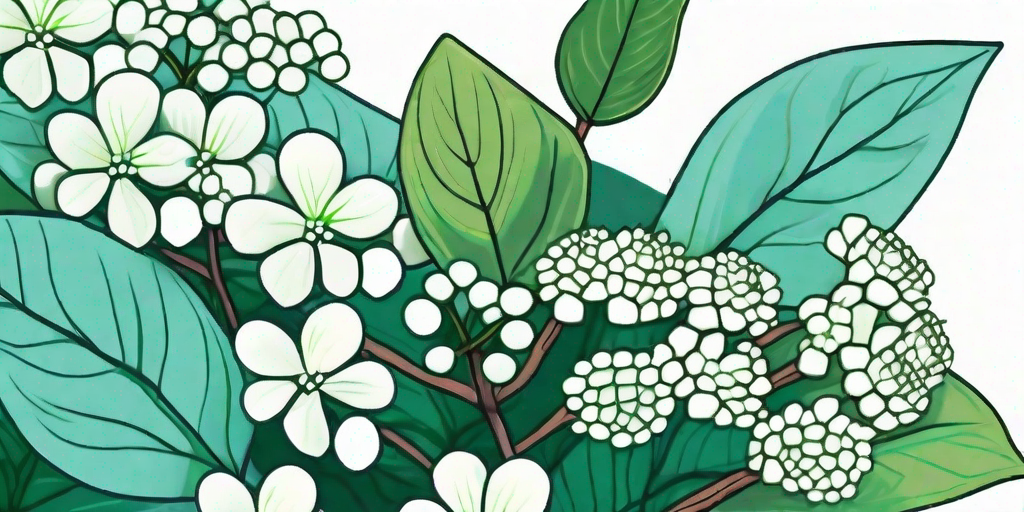
Viburnum, a versatile and vibrant plant, is a garden's best friend. With its stunning blooms and delightful fragrance, it's the botanical equivalent of a Swiss Army knife. Whether you're a green thumb or a gardening newbie, this guide will help you cultivate and care for this beautiful plant.
Understanding the Viburnum
Before we dive into the nitty-gritty of Viburnum care, let's get to know our green friend a bit better. Viburnum is a genus of about 150–175 species of shrubs or (in a few species) small trees that were previously included in the family Caprifoliaceae.
They're native to the temperate Northern Hemisphere, with a few species extending into tropical montane regions in South America and southeast Asia. In Africa, the genus is confined to the Atlas Mountains. In other words, these plants are well-travelled, just like your favourite globe-trotting aunt.
Types of Viburnum
With so many species, it's no surprise that Viburnum comes in a variety of shapes and sizes. Some are evergreen, some are deciduous, and some can't quite make up their mind. Here are a few popular types:
- Viburnum tinus: An evergreen species with white or pink flowers.
- Viburnum opulus: Known as the guelder-rose, this species is deciduous and features beautiful red berries.
- Viburnum plicatum: This deciduous variety is known for its layered, horizontal branches.
Planting Viburnum
Now that we're acquainted with Viburnum, let's get our hands dirty. Planting Viburnum is a straightforward process, much like baking a cake. Except you won't be able to eat the fruits of your labour... at least not literally.
First, choose a location with full sun or partial shade. Viburnum isn't picky about soil, but it does prefer a well-drained spot. Think of it like a plant that enjoys a good cocktail but doesn't like to get its feet wet.
Step-by-Step Planting Guide
- Prepare the soil: Loosen the soil in your chosen spot and mix in some compost or organic matter. This will give your Viburnum a nutritious start.
- Dig a hole: The hole should be twice as wide and just as deep as the root ball of your Viburnum.
- Place the plant: Put your Viburnum in the hole, making sure the top of the root ball is level with the soil surface.
- Backfill the hole: Fill in the hole, firming the soil gently around the base of the plant.
- Water thoroughly: Give your Viburnum a good drink to help it settle in.
Caring for Viburnum
Once your Viburnum is happily planted, it's time to switch into maintenance mode. But don't worry, caring for Viburnum is easier than trying to keep a houseplant alive. Trust me, I've killed more cacti than I care to admit.
Water your Viburnum regularly during dry periods, and apply a layer of mulch in spring to help conserve moisture and suppress weeds. If you're feeling generous, you can also feed your Viburnum with a general-purpose fertilizer in late winter or early spring.
Pruning Viburnum
Pruning is like giving your Viburnum a haircut, but without the awkward small talk. The best time to prune is in late winter or early spring, before the new growth starts. Remove any dead or damaged wood, and trim back any branches that are growing out of bounds.
Remember, Viburnum is a forgiving plant, so don't worry if your first pruning session looks more like a bad buzz cut. It'll grow back.
Common Viburnum Problems
Like any plant, Viburnum can encounter a few problems. But with a bit of knowledge and care, you can keep your Viburnum looking its best, even when plant pests try to crash the party.
Watch out for aphids, scale insects, and Viburnum beetle. If you spot any of these unwelcome guests, treat your Viburnum with an appropriate insecticide or invite some ladybugs over for dinner. They're nature's pest control.
Viburnum Diseases
Viburnum is generally disease-resistant, but it can sometimes be affected by fungal diseases like leaf spot and powdery mildew. If you notice any discoloured or distorted leaves, treat your Viburnum with a fungicide and try to increase air circulation around the plant.
Remember, prevention is better than cure, so keep your Viburnum healthy with regular watering, feeding, and pruning.
FAQs
How fast does Viburnum grow?
Most Viburnum species grow moderately fast, adding 1 to 2 feet of height per year. So if you're looking for a quick privacy screen, Viburnum could be your plant.
Is Viburnum evergreen?
Some Viburnum species are evergreen, while others are deciduous. Check the label or ask at your local garden centre to make sure you're getting the type you want.
Can Viburnum grow in shade?
Viburnum is a versatile plant that can tolerate a range of light conditions, from full sun to partial shade. However, for the best blooms and berries, a spot with at least a few hours of sun per day is ideal.
Conclusion
So there you have it, a comprehensive guide to growing and caring for Viburnum. With its beautiful blooms, delightful fragrance, and easy-care nature, Viburnum is a great addition to any garden. So why not give it a try? Your garden (and your neighbours) will thank you.















